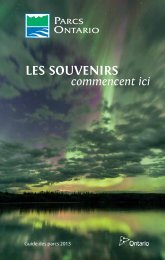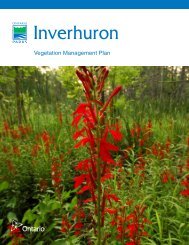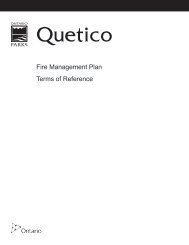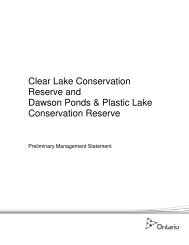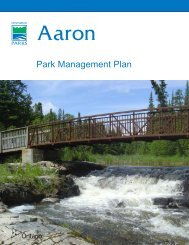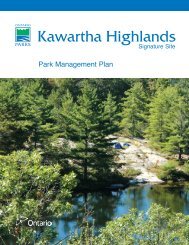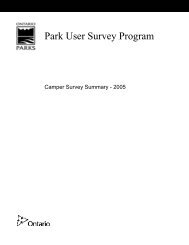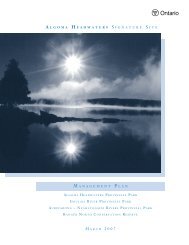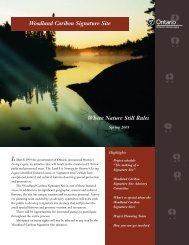Sandbanks Draft Veg Mgmt Plan - Ontario Parks
Sandbanks Draft Veg Mgmt Plan - Ontario Parks
Sandbanks Draft Veg Mgmt Plan - Ontario Parks
Create successful ePaper yourself
Turn your PDF publications into a flip-book with our unique Google optimized e-Paper software.
IMPLEMENTATION SCHEDULE G – Restoration Implementation <strong>Plan</strong><br />
• Use container stock of all plants as they provide more consistent results. There is a<br />
much greater likelihood that volunteers will incorrectly plant bareroot stock resulting in<br />
higher mortality.<br />
• Lay out all plants in their intended locations in advance so that the species are placed in<br />
their appropriate microsite conditions.<br />
• Conduct a demonstration planting to ensure that all volunteers are planting to the same<br />
standard.<br />
• Perform a “tug test” on all trees to check the quality of each planting.<br />
Seeding Method<br />
Areas requiring intensive restoration or lacking a good seed source can be seeded. This<br />
method is less expensive than planting and should be used whenever possible. This will be<br />
particularly important in supplementing the matrix plantings. Partners or volunteers may be<br />
interested in helping with seed collection.<br />
• Seeds can be collected from on site but should never be more than 10% of the seed<br />
from the population nor more than 10% from an individual plant.<br />
• Clean and pre-treat the seeds prior to planting or provide them to a local grower to<br />
propagate (see list in Appendix C). Seed may also be available in mixes from native<br />
plant growers but ensure that no non-native or non-local species are included in the mix.<br />
• The following species are known to successfully establish from seed with the appropriate<br />
pre-planting requirements in order to break seed dormancy. There are some conflicting<br />
opinions on the exact times of stratification but these are rough guidelines intended to<br />
simulate winter.<br />
• Round-leaved and Alternate-leaved Dogwood – 90 days cold stratification<br />
• Green Ash – 90-120 days cold moist stratification<br />
• White Oak – none<br />
• Red Oak – 90 days cold stratification<br />
• Common Elderberry – 90 days cold stratification<br />
• Seeding should occur in the spring when ample moisture is available for germination.<br />
• Once a treed canopy has been established native herbaceous species can be<br />
introduced as seed to encourage the growth of this understorey.<br />
Monitoring and Adaptive Management<br />
Follow-up monitoring is essential to this project, as subsequent restoration efforts<br />
will be based on the successes and lessons learned during the initial phases.<br />
Monitoring methods and stations can be set up by zone staff, and can be checked by trained<br />
summer staff.<br />
The location and abundance of all invasive species (particularly European Buckthorn,<br />
Norway Maple,and non-native pines) should be recorded to allow control strategies to be put<br />
in place according to Appendix D.<br />
For all sites restored in the first phase, and sites where intensive restoration has taken<br />
place, the following monitoring program should be followed. At subsequently restored sites<br />
less detailed monitoring (tallies only) can take place. Results from this monitoring will<br />
determine the success of restoration methods and needs for improvement. If different<br />
experimental techniques are attempted the monitoring should be done to allow simple<br />
statistical comparisons of techniques.<br />
<strong>Sandbanks</strong> <strong>Veg</strong>etation Management <strong>Plan</strong> A-28<br />
<strong>Ontario</strong> <strong>Parks</strong>, SE Zone<br />
2009



